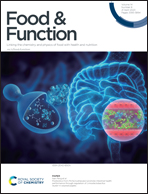Comparative in silico and in vitro study of the stability and biological activity of an octapeptide from microalgae Isochrysis zhanjiangensis and its truncated short peptide
Abstract
In this study, the structural characteristics and active sites of the octapeptide (IIAVEAGC), the pentapeptide (IIAVE) and tripeptide (AGC) were studied in silica and in vitro. The quantum mechanics results show that the pentapeptide has better structural features. In addition, the docking of three peptides with Keap1 was compared through molecular docking, indicating that the potential molecular mechanism may show antioxidant activity by occupying the Nrf2 binding site on Keap1. The above results are consistent with the cell (SH-SY5Y cell) experiment. In the cell experiment, the three peptides can reduce the damage of hydrogen peroxide to cells under a non-toxic effect. Among them, pentapeptide has better activity than the other two peptides, and can inhibit the production of reactive oxygen species and reduce the potential damage to the mitochondrial membrane. Interestingly, these three peptides can promote the nuclear expression of Nrf2 and inhibit the PI3K, MAPK, and NF-κB signaling pathways’ corresponding influence, but their influence degree is different. This study can provide a theoretical basis for the structure–activity relationship of the active peptide, and also broaden the field of vision for the application of the polypeptide from the microalgal Isochrysis zhanjiangensis in food.



 Please wait while we load your content...
Please wait while we load your content...